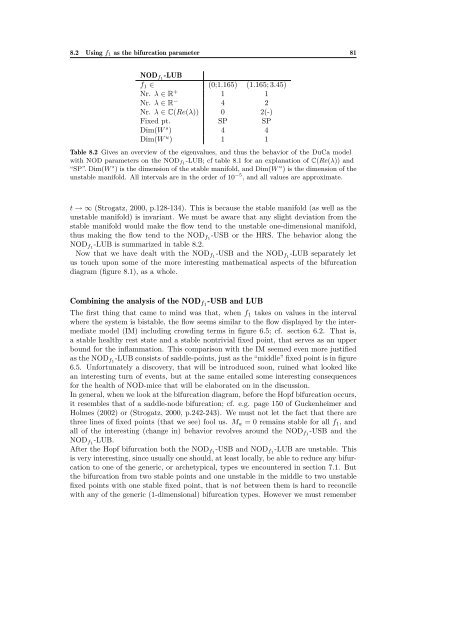nr. 477 - 2011 - Institut for Natur, Systemer og Modeller (NSM)
nr. 477 - 2011 - Institut for Natur, Systemer og Modeller (NSM)
nr. 477 - 2011 - Institut for Natur, Systemer og Modeller (NSM)
You also want an ePaper? Increase the reach of your titles
YUMPU automatically turns print PDFs into web optimized ePapers that Google loves.
8.2 Using f1 as the bifurcation parameter 81<br />
NODf1-LUB<br />
f1 ∈ (0;1.165) (1.165; 3.45)<br />
Nr. λ ∈ R + 1 1<br />
Nr. λ ∈ R − 4 2<br />
Nr. λ ∈ C(Re(λ)) 0 2(-)<br />
Fixed pt. SP SP<br />
Dim(W s ) 4 4<br />
Dim(W u ) 1 1<br />
Table 8.2 Gives an overview of the eigenvalues, and thus the behavior of the DuCa model<br />
with NOD parameters on the NODf1-LUB; cf table 8.1 <strong>for</strong> an explanation of C(Re(λ)) and<br />
“SP”. Dim(W s ) is the dimension of the stable manifold, and Dim(W u ) is the dimension of the<br />
unstable manifold. All intervals are in the order of 10 −5 , and all values are approximate.<br />
t → ∞ (Str<strong>og</strong>atz, 2000, p.128-134). This is because the stable manifold (as well as the<br />
unstable manifold) is invariant. We must be aware that any slight deviation from the<br />
stable manifold would make the flow tend to the unstable one-dimensional manifold,<br />
thus making the flow tend to the NODf1-USB or the HRS. The behavior along the<br />
NODf1-LUB is summarized in table 8.2.<br />
Now that we have dealt with the NODf1-USB and the NODf1-LUB separately let<br />
us touch upon some of the more interesting mathematical aspects of the bifurcation<br />
diagram (figure 8.1), as a whole.<br />
Combining the analysis of the NODf1-USB and LUB<br />
The first thing that came to mind was that, when f1 takes on values in the interval<br />
where the system is bistable, the flow seems similar to the flow displayed by the intermediate<br />
model (IM) including crowding terms in figure 6.5; cf. section 6.2. That is,<br />
a stable healthy rest state and a stable nontrivial fixed point, that serves as an upper<br />
bound <strong>for</strong> the inflammation. This comparison with the IM seemed even more justified<br />
as the NODf1-LUB consists of saddle-points, just as the “middle” fixed point is in figure<br />
6.5. Un<strong>for</strong>tunately a discovery, that will be introduced soon, ruined what looked like<br />
an interesting turn of events, but at the same entailed some interesting consequences<br />
<strong>for</strong> the health of NOD-mice that will be elaborated on in the discussion.<br />
In general, when we look at the bifurcation diagram, be<strong>for</strong>e the Hopf bifurcation occurs,<br />
it resembles that of a saddle-node bifurcation; cf. e.g. page 150 of Guckenheimer and<br />
Holmes (2002) or (Str<strong>og</strong>atz, 2000, p.242-243). We must not let the fact that there are<br />
three lines of fixed points (that we see) fool us. Ma = 0 remains stable <strong>for</strong> all f1, and<br />
all of the interesting (change in) behavior revolves around the NODf1-USB and the<br />
NODf1-LUB.<br />
After the Hopf bifurcation both the NODf1-USB and NODf1-LUB are unstable. This<br />
is very interesting, since usually one should, at least locally, be able to reduce any bifurcation<br />
to one of the generic, or archetypical, types we encountered in section 7.1. But<br />
the bifurcation from two stable points and one unstable in the middle to two unstable<br />
fixed points with one stable fixed point, that is not between them is hard to reconcile<br />
with any of the generic (1-dimensional) bifurcation types. However we must remember
















